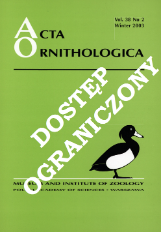- Tytuł:
-
Breeding of the house martin
Acta Ornithologica, vol. 36, no. 1
Population density and breeding ecology of the house martin Delichon urbica in Pomerania (NW Poland)
Ekologia lęgowa oknówki na Pomorzu - Autorzy:
- Górska, Ewa
- Współwytwórcy:
-
Meeting of the European Ornithologists' Union (2 ; 1999 ; Gdańsk)
Polska Akademia Nauk. Muzeum i Instytut Zoologii - Słowa kluczowe:
-
population density
swallows
1985-95
zagęszczenie populacji
breeding birds
Oknówka -- biologia lęgowa -- Polska -- Pomorze (region) -- konferencje [KABA]
liczebność
Pomerania
Delichon urbica
House Martin
congresses
birds
Aves
Ptaki lęgowe [KABA]
Hirundinidae
Poland
breeding ecology
breeding biology
jaskółkowate - Data publikacji:
- 2001
- Wydawca:
- Muzeum i Instytut Zoologii PAN
- Język:
-
polski
angielski - Linki:
- https://rcin.org.pl/dlibra/publication/edition/45288/content Link otwiera się w nowym oknie
- Prawa:
-
Prawa zastrzeżone - dostęp ograniczony
Rights Reserved - Restricted Access - Źródło:
-
MiIZ PAN, call no. P.4568, Vol. 36, No 1
http://katalog.pan.pl/webpac-bin/228bmiizEN/wgbroker.exe?new+-access+top+search+open+NR+xx002753729
http://katalog.pan.pl/webpac-bin/228bmiizPL/wgbroker.exe?new+-access+top+search+open+NR+xx002753729
MiIZ PAN, sygn. patrz sygn. czas. P.257, Vol. 36, No 1
MiIZ PAN, sygn. patrz sygn. czas. P.4568, Vol. 36, No 1
MiIZ PAN, call no. P.257, Vol. 36, No 1 - Dostawca treści:
- RCIN - Repozytorium Cyfrowe Instytutów Naukowych
- Książka
Menu główne
Wyszukiwarka
Treść główna
